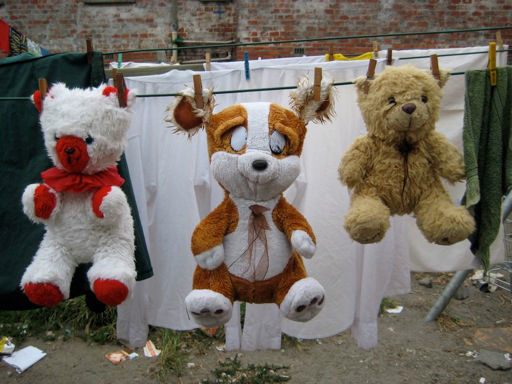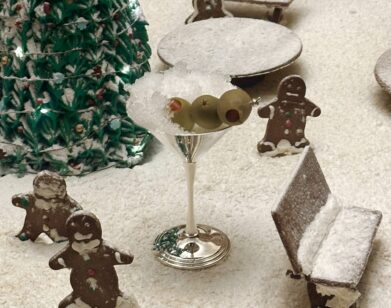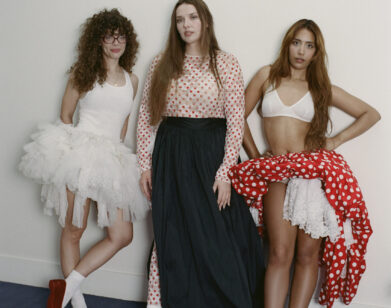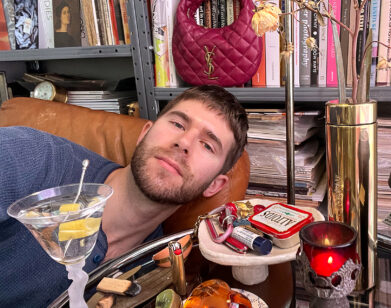Tom Scott, Upside-Down and Inside-Out

Tom Scott by Mathias Kessler
The enterprising Mr. Tom Scott has gone from accessories to women’s, men’s and home wear. Now he has a home base, in the form of a new store, his first, on the Lower East Side. What’s next, of course, but more stores? Here the designer explains why everything is better upside-down, and his directional inspiration boards.
BERACASA: The name on your store is upside-down!
SCOTT: That’s because a lot of my pieces you can wear upside-down. You play with how you wear them. But I guess it’s also my commentary on logos. I grew up thinking my name was so boring, so I felt I needed to do something a little more interesting. It was actually a mistake when someone printed it out upside-down, but we thought it looked better like that.
BERACASA: So the correlation between that and wearing your clothes upside down? Did that happen organically, because you said the printer messed up?
SCOTT: It was just a mistake.
BERACASA: So what are some of the pieces that are worn backwards?
SCOTT: One of the pieces, I’ll show you, [gestures to poncho] this you can wear multiple ways: as a poncho; as a wrap; and you can wear it like a hood. A lot of times a customer can come in and we’ll show her different ways she can wear things, but she can decide how she likes to wear it best. I think my pieces look quite different on the hanger than they do on the body.
BERACASA: How did you start? Was designing something you learned early on?
SCOTT: I studied textiles in college. I’m half-Scottish, half-Italian. So on the Scottish side of my family…
BERACASA: How did that happen?
SCOTT: It’s a very hot and cold mix. It didn’t last very long with my parents.
BERACASA: One was too fiery and one was too quiet.
SCOTT: I’d say cold. My father was kind of a cold Scot and my mom was a hot Italian. Oil and water I guess.
BERACASA: …So you studied textiles…
SCOTT: It started with my family, I guess. I never really thought about going into fashion, but my grandmother was a lace-maker. And my father was a carpet-weaver. I guess I always had textiles in my blood.
BERACASA: And along with that comes the art of craft, because it’s not just textiles that you’re creating …? I feel like when you grow up respecting the beauty of craft and seeing the pride in creating, it really changes your perspective.
SCOTT: I grew up with my grandmother and she used to make really intricate things. So then I studied textiles and then I worked at Ralph Lauren for seven years. After that I worked on my own collection, starting with accessories. I was very interested in the idea of accessories that you can wear on your body, like a scarf that has a turtleneck. When I first started we did sweaters without the body, so they were just two sleeves and a crewneck.
BERACASA: What are your top two aesthetic priorities when it comes to designing?
SCOTT: Definitely concept and construction. We use luxury materials—cashmere, alpaca—and now we’re branching out into a full collection. It’s not just knitwear; we’re working on woven things for spring and for fall we’ve got coats.
BERACASA: Who made these little clay ashtrays, which are painted so loosely in such bright colors? Did they come from a kid in summer camp? Do you have children?
SCOTT: That’s a new project that we’re doing in the store. My friend got me the pottery in China. You wouldn’t necessarily think these are Chinese. It looks like something you make in Cub Scouts. We’re selling these found objects and calling them our “Summer Camp” series because it looks like you made them at summer camp.
BERACASA: You’re like the Marcel Duchamp of fashion, selling readymades.
SCOTT: I’m a collector of all kinds of quirky things. And I do want this space to feel like home in a certain way. I want it to be a showcase of all these objects and all these things that I have been collecting over the years. I love things wrapped in balls—like wire wrapped in balls, thread wrapped in balls, and this is a child’s hat form.
BERACASA: You’re selling those too?
SCOTT: Yeah we’re selling them, balls of yarn and balls of rubber band and tape. We’re doing a lot of one-off stuff-like those pillows over there.
BERACASA: You’re moving so fast! Already into housewares? Can you tell me a little bit about the way you start your collection, how you get focused?
SCOTT: We make a book, and that book typically represents the concept for the collection. It’s comprised of mostly found images. I used to do them in a really collage style, but now I’ve been cleaning up how I look at the images.
BERACASA: Where do you get these images?
SCOTT: They come from all different sources. A lot of these things we photograph ourselves in the studio, like objects we find or pieces of satin. It can be something as high-art as a Wolfgang Tillmans photo, but we did a piece in the spring inspired by a mosquito net. I went to Africa in April.
Lookbook by Tom Scott
BERACASA: Love, where did you go?
SCOTT: I went to South Africa and Tanzania. It was amazing. This photograph of teddy bears out to dry is actually a photographs I took in Africa. I met the girl, who had hung up all her stuffed animals to dry on a clothesline. I was looking at the arrangement and she tapped me on the shoulder and said “Do you like those?” I said yeah, and she said, “Thank you.”
BERACASA: I’m planning on going to Kenya over Christmas. Did you love it?
SCOTT: So cool. This is Melanie Bonajo, do you know her work? I was actually reading this book of Bonajo’s—she does all this furniture—and it’s inspiring because when she was a little kid she refused to go to sleep so her parents used to tie her to her bed. So this is how we start a collection.
BERACASA: Oh no! (RIGHT: PHOTO BY TOM SCOTT)
SCOTT: She would literally get up and run around the house with this mattress attached to her back. So now you know why she does this kind of work.
BERACASA: Well it’s wonderful to have such a strong point of view. How long have you been doing this?
SCOTT: Seven or eight years, but more seriously five or six. The first couple of years I was trying things here and there, not so seriously.
BERACASA: So how is your personal life? Do you have a personal life?
SCOTT: I think so.
BERACASA: How has it been affected by all this work?
SCOTT: I live my work and that’s the most important thing to me, so I’m happy to work late. A lot of people I work with are very dear friends of mine, so it all kind of melds together into one. When you are really close to the people you work with, you can go out and work for a little while and go out and have a couple of drinks.
BERACASA: Which is great, some people need the separation and some people feel comfortable being together. I think that’s great.
SCOTT: Yeah whenever I worked in the industry, I always thought it was so strange how people were so separated with their lives and work.
BERACASA: So a lot of people work in an industry that they’re not in love with. That’s a very different story.
SCOTT: So they want to run out the door at five o’clock and go home. You see people in midtown and they’re running for that train.
Tom Scott’s new store is located at 55 Clinton Street, New York.






